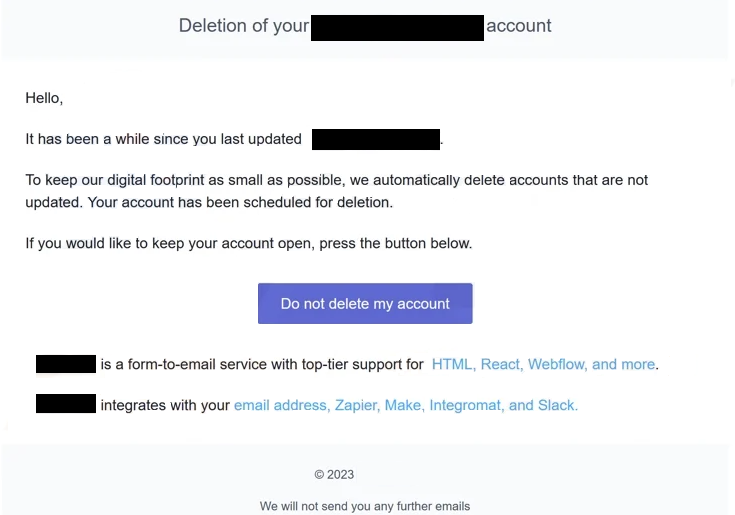“Deletion Of Your Account” is a phishing email that targets email login credentials. This is a relatively new phishing campaign but it’s not anything we haven’t seen before. The phishing email claims that because you have not used it in a while, your email account will be deleted. To stop the deletion process, the email asks you to click on the provided link and then log in to your account. Users who fall for this would end up revealing their email account credentials to malicious actors.
“Deletion Of Your Account” is a pretty typical phishing email. The idea of threatening to delete users’ email accounts is also not unique. Hundreds if not thousands of other phishing campaigns do the same thing.
The “Deletion Of Your Account” email first explains that you’ve not logged into your email account for a while. To supposedly keep their digital footprint as small as possible, the email provider automatically deletes accounts when they are not updated for a certain period of time. Unless you click on the “Do not delete my account” link provided in the email, the account will supposedly be deleted.
Hello,
It has been a while since you last updated -.
To keep our digital footprint as small as possible, we automatically delete accounts that are not updated. Your account has been scheduled for deletion.
If you would like to keep your account open, press the button below.
Do not delete my account
– is a form-to-email service with top-tier support for HTML, React, Webflow, and more.
– integrates with your email address, Zapier, Make, Integromat, and Slack.
© 2023 –
We will not send you any further emails
If you were to click on the button, you would be taken to a fake email login page and asked to provide your email account login credentials. If you type in your password, it would be sent to the malicious actors operating this phishing campaign. Because email accounts are linked to hundreds of other accounts, having your email account accessed by someone can have very serious consequences. Malicious actors in control of your email account could access your other accounts and cause damage. For example, they could gain control of your Facebook account and send messages to your contacts asking for money.
Email accounts are a hot commodity among cybercriminals so you need to be extra careful with your credentials. What you can do is learn to identify phishing emails so you can avoid revealing your information.
How to recognize phishing emails
Regular users are usually targeted by generic phishing emails, which means they are quite easy to recognize. More sophisticated and convincing phishing emails usually only target specific people whose information the malicious actors have. But most users deal with generic ones.
Phishing emails are usually made to appear like they’re sent by legitimate companies. For example, this “Deletion Of Your Account” email wants you to believe that it’s sent by Google’s Gmail. However, it does not look professional enough to be actually sent by Google.
The way an email addresses you can often help identify whether it’s legitimate or phishing/malicious. This “Deletion Of Your Account” email uses a simple “Hello” instead of using your name to address you. Legitimate emails generally address users by name or rather the names users have given to the service provider. Words like “Customer”, “Member”, and “User” are usually a sign of a potentially malicious or spam email.
Grammar and spelling mistakes are pretty common in phishing emails, which is why it’s another good way to identify non-legitimate emails. You will not see any mistakes in emails sent by legitimate companies, especially not in automatic ones, because that looks very unprofessional.
Phishing emails usually claim that there’s something wrong with your account to force you to click on links and try to log in. This is a very common tactic that is applicable even in the case of the “Deletion Of Your Account” email. But whenever you receive an email asking you to do something, do not click on the links. If you think there could be something wrong with your account, access it manually instead of clicking on the link.
Lastly, before you log in anywhere, always check the URL of the site. Phishing sites can often look more or less identical to legitimate ones but the URL will never be the same. Malicious actors may use various tactics to make the URL seem more real but as long as you pay attention and carefully check it, you should be able to notice the differences quite easily.
“Deletion Of Your Account” phishing email removal
If this email lands in your inbox, you can just remove “Deletion Of Your Account” phishing email. If you have interacted with it, clicked on the button, and typed in your login credentials, you need to change your email account password immediately. If you cannot access your email account, contact the provider to see if you can get it back.
Site Disclaimer
2-remove-virus.com is not sponsored, owned, affiliated, or linked to malware developers or distributors that are referenced in this article. The article does not promote or endorse any type of malware. We aim at providing useful information that will help computer users to detect and eliminate the unwanted malicious programs from their computers. This can be done manually by following the instructions presented in the article or automatically by implementing the suggested anti-malware tools.
The article is only meant to be used for educational purposes. If you follow the instructions given in the article, you agree to be contracted by the disclaimer. We do not guarantee that the artcile will present you with a solution that removes the malign threats completely. Malware changes constantly, which is why, in some cases, it may be difficult to clean the computer fully by using only the manual removal instructions.
